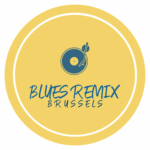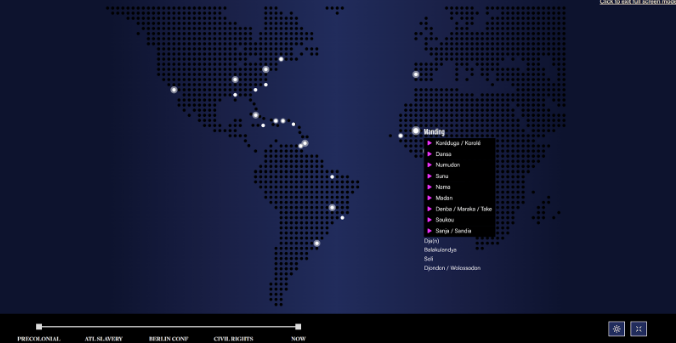Led by Deirdre C. Molloy
The Unity Atlantic project investigates how rhythm, dance, and memory travel and connect across the African diaspora. The centerpiece is the Unity Atlantic Rhythm Map, made in collaboration with Aurélie Capelle-Sigère. It is an interactive digital tool tracing rhythms across Africa, the Caribbean, the Americas, and Europe. Visitors can experience the map through short guided video tours in English and French. Visitors can explore the map through short guided video tours available in English and French.
The project merges research, performance, and multimedia creation, creating a living archive of Black Atlantic heritage. Alongside the map, the initiative includes the narrative film Drum Calls | Body Recalls and the Black Atlantic Space-Time dataset, offering an immersive exploration of historical memory, rhythm, and embodied cultural knowledge.
This series unfolds across four chapters: exploring the interactive map, introducing its creators and their collaborative process, presenting living rhythm heritage through film and digital media (with the chapter authored by Dee Molloy and Aurélie Capelle-Sigère), and reflecting on blues and diaspora identity through the DecodeNoir archives and Dee Molloy’s research.
Quick Links:
- Unity Atlantic Rhythm Map: https://unityatlantic.org/
- Drum Calls | Body Recalls teaser: https://doi.org/10.34847/nkl.5c091tx1
- Black Atlantic Space-Time dataset: https://nakala.fr/collection/10.34847/nkl.c3ebqb48
- Dee digital exhibition prototype: www.decodenoir.org
Molloy, D. C. (2024). From Blues Dance to African Diaspora Identity : Diaries, Dialogues, Dreams of Unity (Version 1) [NAKALA – https://nakala.fr (Huma-Num – CNRS)]. https://doi.org/10.34847/NKL.EFB8NLDA

Chapter 1 – Exploring the Unity Atlantic Rhythm Map
A living cartography of rhythm, memory, and the Black Atlantic
The Unity Atlantic Rhythm Map is more than a digital tool, it is a living experiment in mapping rhythm, dance, and memory across the African diaspora. Created by Dee Molloy (Unity Atlantic) in collaboration with Aurélie Capelle-Sigère, the map is a browser-based prototype that invites us to explore how music and movement travel across oceans, cultures, and time.
A cartography of rhythm
At its heart, the project asks: How do rhythms tell stories? By tracing links between Africa, the Caribbean, the Americas, and Europe, the map reveals connections often hidden in traditional history books. Each point on the map is a doorway into sound, movement, and cultural exchange.
Access the map online:
→ https://unityatlantic.org/
How the Map Works
- White dots represent the origin of each rhythmic code — ancestral knowledge that continues to resonate today.
- Click on a dot to explore a rhythmic code, which may include text, audio, video, or all three.
- Pink arrows open videos.
- Each code shows up to six videos, all requiring sound to fully experience the rhythm.
- The text tab credits each video and provides cultural and contextual details. → You can use browser translation tools to read the text in your preferred language.
Guided tours are available in:
- English (3 minutes): https://doi.org/10.34847/NKL.515DH8N
- French (3 minutes): https://doi.org/10.34847/NKL.CAC917F9
Work in progress
This is still an evolving project. A much fuller account of the Rhythm Map is planned for December 2025 in Conversations Across the Field of Dance Studies (University of Michigan Press). Until then, this online prototype offers a glimpse of what is to come.
Known issues:
- iPhone users may have display problems.
- If white dots or stars do not appear,
Please contact the author at dublinator@netscape.net or 122115291@umail.ucc.ie if you find more issures.
Part of a wider journey
The Rhythm Map is both artwork and research. It brings together digital humanities, dance studies, and cultural memory, highlighting the ways music and movement embody histories of migration, resistance, and creativity. It is also collaborative by nature: the map grows out of lived experience, community exchange, and ongoing dialogue within the African diaspora.
The Rhythm Map is only one piece of Dee’s larger Unity Atlantic project, which also includes:
- Black Atlantic Space-Time dataset (2023–24): https://nakala.fr/collection/10.34847/nkl.c3ebqb48
Black Atlantic Space-Time Portfolio (2024): https://doi.org/10.34847/NKL.FCF71S7D

Chapter 2 – Meet the Authors: Dee Molloy & Aurélie Capelle-Sigère
Where research, rhythm, and identity come together
The Unity Atlantic project is the result of a creative and scholarly collaboration between Dee Molloy and Aurélie Capelle-Sigère, two artists whose practices converge at the intersection of dance, digital media, and the African diaspora. Unity Atlantic itself is a container created by Dee to facilitate collaborations flowing from her PhD research.
Dee Molloy
Originally from Ireland, Dee has danced socially across New York, Sydney, and France, exploring genres from techno, house, and hip hop to vintage blues. In 2019, she launched Dance Your Blues Away and moved to Toulouse to pursue full-time dance, where she connected with Aurélie.
Dee’s academic work complements her practice. She earned a First Class Honours Masters in Ethnochoreology (University of Limerick, 2022) and is now a PhD candidate at University College Cork and the University of Toulouse. Her research examines how dance and rhythm shape African diaspora identities. Her work blends scholarly inquiry with creative expression, exemplified by the Unity Atlantic Rhythm Map, a multimedia interactive archive of Black Atlantic rhythms.
Aurélie Capelle-Sigère
Raised in Martinique, Aurélie grew up immersed in Afro-Caribbean and urban music. She began hip hop training at 16 and continued at the University of Paris 8 Saint-Denis, a historical center of French hip hop. Her practice spans urban dance, traditional African dance, and swing, bridging her West Indian roots with metropolitan French culture. For Aurélie, dance is both a personal and cultural practice, a way to honor heritage, connect with community, and transmit cultural memory.
Collaboration in Unity Atlantic
For the 2023–24 Project Manifest Artist Journey, Aurélie joined Unity Atlantic as a co-creator. Transdisciplinary co-producers included Code Your Future (UK) and Gerador (Portugal). Dee led the project for a full year, serving as director, producer, dancer, choreographer, researcher, sound designer, musical arranger, costume stylist, and audiovisual editor. She trained, built a database, recorded with musicians, secured funding, and choreographed ensemble screendances for the Manifest exhibition.
Aurélie collaborated closely in the studio, rehearsing singing and dance roles for a year. She also assisted on video shoots, ensemble choreography, wardrobe, and vocals. Together, they explored themes central to Project Manifest, including Afro-descendant cultural statelessness and fragmentation.
Through Unity Atlantic, Dee and Aurélie respond to Eurocentric narratives and ongoing colonial violence by embodying Afro-diasporic unity. Their work celebrates a rich Black Atlantic intangible heritage, creating audio-visual narratives that honor ancestral memory while connecting research, performance, and community engagement.
Chapter 3: Read Dee Molloy and Aurélie Capelle-Sigère
“Living Rhythm Heritage”
Unity : Dee Molloy, Aurélie Capelle-Sigère 2024
Also accessible here
Black Atlantic Space-Time is expressed in 2 formats – the narrative movie Drum Calls | Body Recalls and the interactive Unity Map. Both assume a scientific premise of rhythm transmission through muscle memory rather than through DNA or ‘blood’. Slavery fragmented this heritage, creating new drum-dance circles of innovation.
Drum calls | Body recalls: narrative video, music, poem by Kamau Brathwaite.
Unity Atlantic Rhythm Map: this digital map of intangible heritage telescopes time and space to honour the cultural constellation of music and dance connecting Africa and the Americas. Raising consciousness of a shared heritage of historic trauma and generative cycles of rhythm heritage, the Unity Map offers an Afrocentric journey through space-time. The Unity Map is the doctoral research-creation of Dee Molloy, using multimedia ethnography, dance, archival sources and social media.
The Unity Map’s core functionality is using the internet to serve curated video streams and contextual text/map data. The customised audiovisual dot-map interface has animated hot-spots that open into lists and from there, the user clicks on a button to open a modal window. Each modal window has a text tab and a media tab, containing audio and video. The current live build was co-produced with Code Your Future UK and Gerador Portugal, and launched in 2024 at l’Atelier in Nantes France, at the EU-funded Manifest group art exhibition.
This research-creation prototype flows from international co-productions lead by PhD candidate Dee Molloy, who is soley responsible for the site content. Subject to future funding and collaborations, she aims to build and maintain the Black Atlantic dance map freely available online, in dialogue with communities, as interactive resource to which the public can contribute.

The creative process
Unity is a container created by Dee Molloy for collaborations that flow from her PhD research. For this project, Martiniquan dancer Aurélie Capelle-Sigère joins Unity. Transdisciplinary co-producers include Code Your Future (UK) and Gerador (Portugal).
Dee lead the project through a year of creation as director, producer, dancer, choreographer, researcher, sound designer, musical arranger, costume stylist, audio-visual editor. Dee continued her dance research and training, built a database, recorded with musicians, sought funding and choreographed screendances for this Manifest exhibition. Aurélie joined Dee in the studio for a year of partner dance and rehearsals for singing and dancing roles in the project. Aurélie also assisted with choreography, wardrobe and vocals.Unity engages deeply with the Black Atlantic themes from lived experience of Afrodescendant cultural statelessness and fragmentation. In reply to Eurocentric narratives that continue colonial
violence, we embody Afrodiasporic unity: a rich Black Atlantic intangible heritage, and audio-visual narrative that honours our ancestors.
Chapter 4: Teasing one of Dee’s Work – “DecodeNoir Archives” and “African Diaspora Identity: Exploring Blues, Dance, and Heritage”
The blues is a living archive of African diaspora memory, creativity, and identity. Through its rhythms, movement, and storytelling, the blues embodies histories of migration, resilience, and cultural continuity. This is the perspective central to Dee C. Molloy’s work, including her paper “From Blues Dance to African Diaspora Identity: Diaries, Dialogues, Dreams of Unity.”
DecodeNoir: Archiving Lived Experience
The DecodeNoir archives offer a rich collection of interviews, videos, and multimedia documents that capture the voices of dancers, musicians, and culture bearers connected to blues and African diaspora practices. For Dee, these archives are both a research tool and creative resource, allowing her to trace how dance and rhythm communicate identity and memory across generations.
In her paper, Dee uses autoethnography to explore her own Afro-Caribbean-American and Irish identity while creating a decolonized narrative of African diaspora heritage. She examines how Africanist arts, circle dances, and vernacular knowledge transmit tradition, foster innovation, and resist Eurocentric, colonial narratives. The archives DecodeNoir amplify these insights, providing real-life examples of how rhythm, dance, and cultural memory operate in living communities.
Connecting Research and Practice
In her research, Dee asks: How does the practice of African diaspora aesthetics across space and time consciously inform dance expression and identity? Through 12.5 hours of ethnographic interviews, original dance recordings, and curated multimedia, she maps connections between ancestral heritage and contemporary creative practice. The DecodeNoir platform, alongside her digital exhibition prototype (www.decodenoir.org), allows these voices to exist in a shared digital space, bridging individual experience and collective lineage.
By connecting the historical, the embodied, and the digital, Dee visualizes links between diaspora communities, superimposing them on maps of slave routes, and decoding Africanist heritage lost through displacement and colonial erasure. The project demonstrates how dance and rhythm can reclaim cultural memory, strengthen diasporic identity, and challenge colonial legacies.
Explore the archives and Dee Molloy’s research:
- Molloy, D. C. (2024). From Blues Dance to African Diaspora Identity : Diaries, Dialogues, Dreams of Unity (Version 1) [NAKALA – https://nakala.fr (Huma-Num – CNRS)]. https://doi.org/10.34847/NKL.EFB8NLDA

